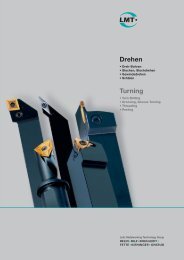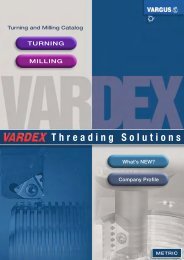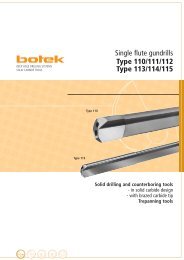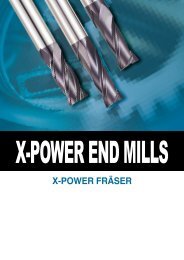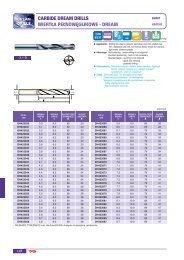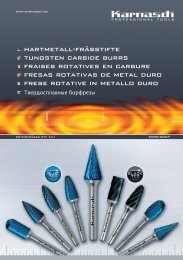Gear Cutting Tools
Hobs - Torion
Hobs - Torion
- No tags were found...
Create successful ePaper yourself
Turn your PDF publications into a flip-book with our unique Google optimized e-Paper software.
High-speed<br />
cutting (HSC)<br />
The advantages of high-speed<br />
cutting are:<br />
■ High surface quality and short<br />
machining times<br />
(depending upon the machining<br />
application)<br />
■ Low cutting forces, with<br />
resulting benefits for the<br />
dimensional accuracy of the<br />
workpiece and the tool life<br />
Owing to the low contact time<br />
between the chip and the cutting<br />
edge, the heat which is generated<br />
does not have time to flow into the<br />
tool or the workpiece. The tool and<br />
the workpiece thus remain relatively<br />
cold. By contrast, the chips<br />
are heated very strongly and must<br />
be removed very quickly in order<br />
to prevent the machine from heating<br />
up.<br />
In an example application, HSC<br />
machining without cooling lubricant<br />
led to the workpieces being<br />
heated to approximately 50-60 °C.<br />
At the point of chip generation,<br />
however, far higher temperatures<br />
occur which under certain circumstances<br />
may rise to approximately<br />
900 °C, as indicated by incandescent<br />
individual chips. Based upon<br />
these observations, a transverse<br />
microsection from a workpiece<br />
subjected to the dry machining<br />
process under optimum machining<br />
conditions for the HSC hobbing<br />
process was examined for possible<br />
changes to the microstructure.<br />
The tooth flanks machined by the<br />
HSC process and the reference<br />
samples of a turned blank analysed<br />
for the purpose of comparison<br />
revealed no changes to the<br />
microstructure attributable to the<br />
machining process.<br />
As already mentioned, HSC machining<br />
must be considered in<br />
conjunction with dry machining.<br />
The first studies were performed<br />
on HSC hobbing machines in the<br />
early 1990s. This process now<br />
permits dry machining of gears in<br />
a secure process at cutting<br />
speeds of up to 350 m/min.<br />
Applications and<br />
cutting data<br />
The proven applications for solid<br />
carbide tools for gear and pinion<br />
manufacture lie in a module range<br />
from m = 0.5 to m = 4. The tools<br />
are generally manufactured as<br />
stable monoblocs with bore- or<br />
shank-type mounting arrangement.<br />
The shank type is recommended<br />
for smaller tools. The<br />
cutting speeds are in the range<br />
from 150 to 350 m/min, according<br />
to the module size and process<br />
(dry or wet machining).<br />
The diagram shows the difference<br />
in cutting speeds for dry and wet<br />
hobbing of materials with a range<br />
of tensile strengths. The values in<br />
the diagram apply to a solid carbide<br />
hob, m = 2.<br />
Substantially higher cutting speeds<br />
can be achieved with dry hobbing<br />
than with wet hobbing.<br />
320<br />
300<br />
<strong>Cutting</strong> speed v c [m/min]<br />
280<br />
260<br />
240<br />
220<br />
200<br />
180<br />
160<br />
140<br />
Dry machining<br />
Wet machining<br />
120<br />
600 700 800 900 1000 1100<br />
Tensile strength [N/mm2 ]<br />
<strong>Cutting</strong> speeds for a range of material tensile strengths, carbide hobbing, dry and wet, module 2<br />
29



